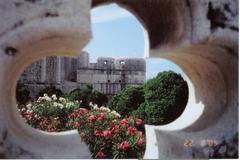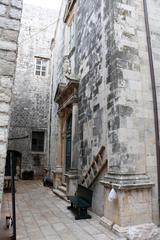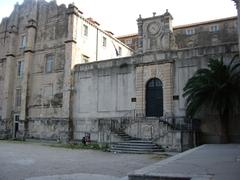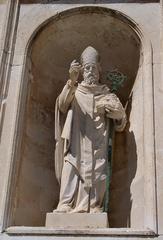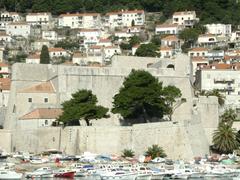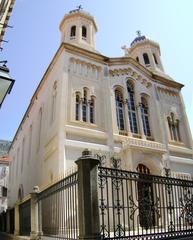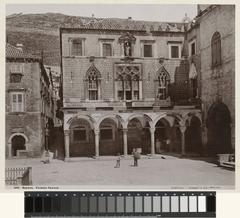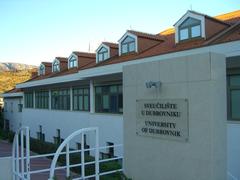
The State Archives in Dubrovnik: Visiting Hours, Tickets, and Historical Sites Guide
Date: 04/07/2025
Introduction: The State Archives Dubrovnik — History and Cultural Significance
Located in the enchanting heart of Dubrovnik’s Old Town, the State Archives Dubrovnik, housed in the illustrious Sponza Palace, represent one of the city’s most vital cultural institutions. With origins rooted in the 11th century and formalized archival practices established in the late 13th century, this repository safeguards over a millennium of documentary heritage. Its extensive collections illuminate the storied past of the Republic of Ragusa, once a major maritime republic and a nexus of Mediterranean diplomacy, commerce, and culture (EHRI Project; Science4Heritage).
The Sponza Palace itself, an architectural masterpiece blending Gothic and Renaissance elements, survived the catastrophic 1667 earthquake. Its resilience has ensured the perpetual preservation of Dubrovnik’s collective memory and today offers visitors an immersive historical experience. In addition to its archival function, the palace serves as a vibrant venue for exhibitions and cultural events that bring the city’s remarkable heritage to life (Wikipedia; Audiala).
This guide provides essential details on visiting hours, ticketing, accessibility, and guided tours, alongside deeper insights into the archives’ extraordinary collections and the palace’s historical and architectural significance. Whether you are a history aficionado, researcher, or curious traveler, this guide equips you to explore Dubrovnik’s layers of history. Additional travel advice and context on nearby attractions ensure your visit is seamless and enriching (Dubrovnik Museums; Just Dubrovnik).
Table of Contents
- Introduction: The State Archives Dubrovnik — History and Cultural Significance
- Origins and Evolution of the Archives
- Highlights of the Collections
- Visiting Information: Hours, Tickets & Accessibility
- Guided Tours and Special Events
- Directions and Nearby Attractions
- Tips for Visiting the Archives
- Frequently Asked Questions (FAQ)
- Sponza Palace: Architecture and Civic Role
- Ticketing and Visitor Details
- Research Access and Special Notes
- Safety and Preservation
- Summary and Call to Action
- References
Origins and Evolution of the Archives
The State Archives Dubrovnik trace their lineage to the city’s medieval record-keeping, with the oldest preserved document being a papal bull from 1022. The appointment of the first state-paid notary in 1278 marks the foundation of a systematic archival tradition. The archive expanded vastly during the Republic of Ragusa’s golden era (1358–1808), eventually becoming centralized in the Rector’s Palace, and later the Sponza Palace, with the establishment of a formal state archivist role by 1783 (Science4Heritage; Wikipedia).
Highlights of the Collections
The State Archives Dubrovnik are a treasure trove of historical documentation, including:
- Bull of Pope Benedict VIII (1022): The oldest preserved document.
- Medieval Charters and Legal Documents: Vital records dating from the 11th century onward.
- Diplomatic Correspondence: Letters and charters from European and global leaders, highlighting Dubrovnik’s extensive diplomatic network.
- Manuscripts and Printed Works: Featuring Dubrovnik luminaries such as Ivan Gundulić and Ruđer Bošković.
- Jewish School Records: Rare documentation from the Dubrovnik Jewish Elementary School (late 19th century).
- Cartographic and Graphic Collections: The second largest in Croatia, with over 4,600 maps, plans, and heraldic items.
- Photographic and Film Heritage: Over 2 million photographs and significant film documentation.
- Registers of Births, Deaths, and Marriages: Essential for genealogical and demographic research.
- Turkish Documents: 15,000 items detailing Dubrovnik’s relations with the Ottoman Empire.
- Glagolitic Manuscripts: Illuminating the region’s linguistic and religious history (Croatian State Archives).
The archives’ continuity and breadth have garnered UNESCO Memory of the World Register status, confirming their international importance (Just Dubrovnik).
Visiting Information: Hours, Tickets & Accessibility
Opening Hours (as of July 2025):
- Summer (April 1 – October 31): 9:00 AM – 8:00 PM, Tuesday to Sunday
- Winter (November 1 – March 31): 9:00 AM – 4:00 PM, Tuesday to Sunday
- Closed: Mondays and select holidays (Dubrovnik Museums)
Ticket Information:
- Adults: €20 (includes 10 museums/galleries, valid for 7 days)
- Students/Pupils: €10
- Family Ticket: €45 (up to 2 adults + children under 14)
- Agencies: €15
- Free Entry: Children under 7, local residents, and members of ICOM/HMD
Purchase tickets onsite or check for online options (Dubrovnik Museums).
Accessibility:
Sponza Palace and the exhibition areas are on flat terrain and accessible to visitors with mobility challenges, though some upper levels may have limited access due to the historic structure. Restrooms and basic facilities are available.
Guided Tours and Special Events
Guided tours of Sponza Palace and the State Archives are available through local operators or as part of broader historical tours. These provide rich context about the building’s architecture and Dubrovnik’s archival legacy. Special exhibitions and cultural events are periodically held—check official sites or the Dubrovnik Museums calendar for updates.
Directions and Nearby Attractions
Location:
Sponza Palace, Stradun (Placa), Dubrovnik Old Town, easily accessible by foot from the Pile or Ploče Gates (Happy to Wander).
Nearby Landmarks:
- Rector’s Palace
- Dubrovnik Cathedral
- City Walls of Dubrovnik
- Dominican Monastery
- Stradun (main pedestrian street)
- Church of St. Blaise (Never Ending Footsteps; Adventurous Miriam)
Tips for Visiting the Archives
- Time Allocation: Plan 20–40 minutes for exhibitions; researchers should arrange ahead for longer archival access.
- Photography: Non-flash photography is permitted in public areas; restrictions apply to original documents—ask staff for details.
- Language: Labels and guides are in Croatian and English; staff speak English.
- Crowds: Visit early or late in the day to avoid peak hours, especially in summer.
- Facilities: Restrooms and nearby cafés are available.
- Security: Bag check may be required; maintain respectful quiet.
Frequently Asked Questions (FAQ)
Q: What are the opening hours?
A: Summer: 9:00 AM – 8:00 PM (Tue–Sun); Winter: 9:00 AM – 4:00 PM (Tue–Sun); closed Mondays and major holidays.
Q: How much is admission?
A: Included in the Dubrovnik Museums combined ticket (€20 adults; discounts for students, families, and free entry for select groups).
Q: Is the site accessible for people with disabilities?
A: The ground floor and atrium are accessible; some upper areas may have limited access.
Q: Can I take photos?
A: Non-flash photography is allowed in exhibition areas; restrictions apply to archival materials.
Q: How do I arrange research access?
A: Contact the archives in advance with credentials—see the official website.
Q: Are guided tours available?
A: Yes, as part of broader city tours or by arrangement with local operators.
Sponza Palace: Architecture and Civic Role
Built between 1516 and 1522, the Sponza Palace is a harmonious blend of Gothic and Renaissance styles, with a striking inner courtyard surrounded by arcades and detailed stonework (Wikipedia). It originally functioned as a customs office, mint, and trading center, and later became the home of the State Archives. The palace’s enduring role as a civic and cultural hub continues today, hosting exhibitions, concerts, and events like the opening ceremony of the Dubrovnik Summer Festival (History Hit).
Ticketing and Visitor Details
- Combined Museum Tickets: Valid for Sponza Palace and other top sites; purchase onsite or check official websites for digital options.
- Visitor Facilities: Restrooms inside the palace; shops and cafés nearby.
- Events: Monitor listings for special exhibitions and cultural events.
- Research Access: Scholars should apply in advance for manuscript consultation.
Research Access and Special Notes
Academic researchers can consult original documents by prior arrangement. Many documents are in Croatian, Latin, or Italian, and some are digitized for online access (Croatian State Archives; University of Toronto Libraries).
Safety and Preservation
Strict preservation protocols apply—do not touch exhibits or documents. The palace is equipped with climate control and safety systems. Follow all staff instructions for the protection of the archives and your safety.
Summary and Call to Action
A visit to the State Archives Dubrovnik in Sponza Palace offers a unique journey through centuries of history, revealing the legacy of the Republic of Ragusa and its enduring influence on Mediterranean culture and diplomacy. With practical visitor information, accessible exhibitions, and a central location, the archives are a must-see for anyone interested in Dubrovnik’s past. For the latest hours, tickets, and events, consult the Dubrovnik Museums official website and consider enhancing your visit with the Audiala app for guided tours and local insights (Audiala).
To deepen your cultural exploration, combine your visit with nearby historic sites, or attend a guided tour for expert interpretation. Stay informed about special exhibitions and plan ahead for a rewarding experience at one of Dubrovnik’s most significant historical venues.
References
- EHRI Project
- Croatia Week
- DAD.hr
- Wikipedia
- Science4Heritage
- Just Dubrovnik
- Croatian State Archives
- Dubrovnik Museums
- Wikipedia: Sponza Palace
- Audiala


